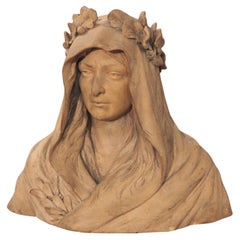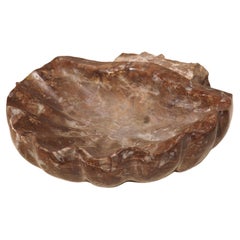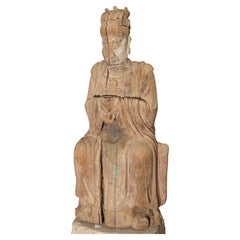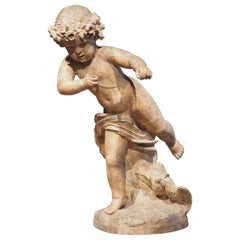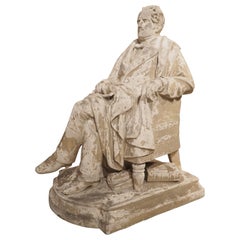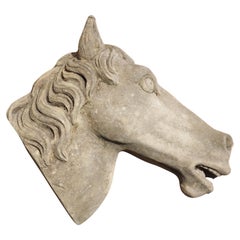Le Louvre French Antiques Decorative Objects
to
156
10
1
49
78
29
11
21
4
8
2
2
1
1
7
6
3
2
1
1
1
72
59
39
37
26
167
165
88
50
5
5
Height
to
Width
to
167
167
167
1
1
1
1
1
Fine French Terracotta Bust of a Woman with Wreath and Veil, 19th/20th Century
Located in Dallas, TX
This terracotta bust of a woman has some exquisite details. Sculpted in France in the late 1800’s to early 1900’s, our subject has long, straight hair emerging from underneath a hood...
Category
Antique Late 19th Century French Busts
Materials
Terracotta
Small Italian Carved Marble Shell Basin or Vide Poche, 20th C
Located in Dallas, TX
Hand-carved in Italy during the 1900’s, this small marble shell basin would make a great vide-poche. A vide-poche (literally “empty pocket”) is a small sto...
Category
20th Century Italian Decorative Dishes and Vide-Poche
Materials
Marble
Antique Wooden Statue of Wenchang Wang, God of Literature and Culture
Located in Dallas, TX
This fascinating antique wooden statue depicts the Taoist God of Literature and Culture, Wenchang Wang. The statue was likely hand-carved in China in the 1700’s, but it is quite possible that it predates the 18th century. An iron stand has been added to the back more recently, although a portion of the back is excavated, indicating that the statue was once part of a larger installation.
Wenchang has been posed in a seated position with his hands clasped in front of his body, which is a common representation of the god in artwork. The hands have a shallow incised section, indicating that Wenchang once held an object. Based on other statues and drawings of Wenchang from this time, it was most likely a hu scepter that once accompanied the statue. Wenchang is clad in an ankle-length robe and a ridged headdress. Although the statue’s color is predominantly natural wood, very old traces of polychrome can be seen throughout the piece indicating that it was once vividly painted.
In China, those who study hard, and test well are often rewarded with high-ranking civil service jobs. The common belief is that Wenchang guides these scholars, leading many to seek his assistance. A statue of this size indicates it could have once been commissioned for a Chinese temple. Today, our wooden statue of Wenchang Wang would make a perfect piece of art in a study or library. It would work well with any contemporary interior, or with an interior displaying other very old Chinese artifacts...
Category
Antique 18th Century Chinese Figurative Sculptures
Materials
Iron
Large 19th Century French Cherub Statue in Terra Cotta Tinted Plaster
Located in Dallas, TX
This large French cherub or cupid statue from the 1800’s is made from plaster that has been tinted to mimic the natural color of terra cotta. The figure ...
Category
Antique 19th Century French Neoclassical Figurative Sculptures
Materials
Plaster
circa 1880 French Plaster Sculpture of Francois Rene De Chateaubriand
Located in Dallas, TX
Made in plaster, circa 1880, this interesting French sculpture depicts Francois Rene de Chateaubriand sitting with his legs crossed in an armchair. A rolled scroll is in his right hand, which rests on his thigh and books and scrolls are strewn beneath the chair. Chateaubriand’s long overcoat is unbuttoned and gathered, showing an elegant frock and bowtie ensemble beneath. Beneath the chair is a shaped plinth with cavetto molding on all sides and “Chateaubriand” incised along the front.
Francois Rene de Chateaubriand was born in Saint-Malo, France in 1768, the youngest of 10 children. A noted politician, historian, and author, Chateaubriand had a profound effect on literature, being the first major figure of Romanticism. Chateaubriand was also the original man of letters, a group of French authors that also had burgeoning political careers. A fellow man of letter, Victor Hugo was so inspired by Chateaubriand that he is known for having said “To be Chateaubriand or nothing”. This French plaster sculpture...
Category
Antique 1880s French Figurative Sculptures
Materials
Plaster
Carved Limestone Horsehead from Italy
Located in Dallas, TX
Hand-carved by an Italian stone mason, this quaint limestone horsehead has excellent proportions. The contour of the cheek, the thick mane, and the slightly open mouth give the head a sense of realism. Carved with amazing precision, the horse can stand upright (face up) without the aid of a stand. Of course, it can also be hung on a wall in the proper orientation. Decorative horse heads of this size were often seen hanging on the exterior wall of a horse barn.
Category
21st Century and Contemporary Italian Garden Ornaments
Materials
Limestone
Carved Limestone Horsehead from Italy
Located in Dallas, TX
Hand-carved by an Italian stone mason, this quaint limestone horsehead has excellent proportions. The contour of the cheek, the thick mane, and the slightly open mouth give the head a sense of realism. Carved with amazing precision, the horse can stand upright (face up) without the aid of a stand. Of course, it can also be hung on a wall in the proper orientation. Decorative horse heads of this size were often seen hanging on the exterior wall of a horse barn.
Category
21st Century and Contemporary Italian Garden Ornaments
Materials
Limestone
Antique 19th Century Italian Maiolica Pot of the Renaissance Style
Located in Dallas, TX
Vivid colors, hand-painted in the Renaissance style, enhance this large maiolica pot from the 1800’s. Maiolica is tin-glazed pottery from Italy that has been decorated over a white background. This pot is considered an istoriato, which is to say that the pot has been decorated with figures, rather than strictly geometric patterns or floral designs.
The maiolica does incorporate floral and foliate motifs, with white flowers that have yellow centers surrounded by blue rings. There are also yellow flowers that are depicted in various stages of nyctinasty (the closing of flowers during the night). The flora is all connected by a series of green and yellow curled leaves. Behind the vegetation is a dark blue background. There are two portraits inside large yellow cartouches that are painted in the middle of the pot. The first is a bearded man, dressed in a light brown tunic...
Category
Antique 19th Century Italian Renaissance Vases
Materials
Maiolica
Large Antique Italian Blue and White Lidded Urn, 19th Century
Located in Dallas, TX
This stunning lidded urn might have once been found in a 19th century Italian apothecary. The front of the shaped urn body has the hand-painted phrase “C. Violaru”, which is the heavily abbreviated form of the Latin word for violet (violaceum). Up until the mid-1700’s, apothecaries would make syrups from violets and use it to treat kidney ailments.
Above the Latin wording is a whimsical musical scene with a man blowing a horn leading a couple who is holding hands over rocky terrain lined with shrubbery. A large house and trees can be seen behind the trio with a pair of mountains in the distance. On the opposite side of the urn is a floral display with a bird perched on a rock. Beneath the bird is a geometric design, possibly a stylized sun with radiating beams of light. Both scenes are segmented by a pair of thin quarter round moldings that encircle the entire vase.
Other hand-painted motifs include floral and foliate margents, geometric patterns, and Vitruvian waves that are infilled with horizontal fluting. The sides of the urn have a fish-scale background beneath two mustachioed mascarons. Both men have been styled in grotesque fashion, with a pair of spiraled horns emanating from their heads. In between the horns is a looping handle that is affixed to the body in similar tight spirals. The domed lid has three scrolled arms that merge in a geometric finial.
The base color of the urn is white, with illustrations in a monochromatic cobalt oxide blue, reminiscent of Delft blue pottery...
Category
Antique 19th Century Italian Urns
Materials
Porcelain
Unusual Carved Walnut Wood Inkwell from France, Circa 1880
Located in Dallas, TX
Hand-carved from walnut in France, circa 1880, this unusual inkwell features foliate and floral motifs. A flip-top lid adorned with a pair of bas relief flowers tops the central pen ...
Category
Antique 1880s French Inkwells
Materials
Walnut
19th Century Hand Painted Faience Jardiniere on Pedestal from Boulogne, France
Located in Dallas, TX
This fantastic faience jardiniere and pedestal were hand-painted in Boulogne, France (formally “Boulogne-sur-Mer”) in the late 1800’s. The vibrant set features heraldic displays set among foliate and floral illustrations. Both the pedestal and the jardiniere have white backgrounds festooned with green leaves and blue, yellow, orange, and purple flowers.
The opening of the jardiniere has asymmetrical edges dotted by small piercings, with flowering vines painted along the inner rim. Exquisite handles, comprised of curled leaves and C-scrolls, are affixed to the sides of the lobed body. Numerous painted motifs grace the area between the handles, including drapery, scrolls, and floral baskets hanging from an arabesque border.
Equally impressive décor can be seen on the tetrapartite stand with a molded top. Each layer of the molding has a different color scheme, ranging from yellow with volute embellishments to solid green. The neck of the stand has been adorned with floral displays above multi-colored scrolls, shells, and scalloped leaves. In the center of each scalloped leaf is a distinct heraldic shield: on one side is a French style shield representing the city of Boulogne, with a swan that symbolizes perfection. On the opposite side is coat of arms topped by a closed crown, emblazoned with a five-fold cross over three roundels, which is the coat of arms for Godfrey of Bouillon, the first ruler of Jerusalem, who was born in Boulogne. Beneath the coat of arms are a pair of scrolled feet adorned with scalloped leaves and scrolls. There are two more feet to the sides that have pierced elements with floral vines beneath.
Our 19th century hand-painted faience jardiniere on pedestal...
Category
Antique 19th Century French Planters, Cachepots and Jardinières
Materials
Faience
Pair of Large Carved Oak Boiserie Elements from Normandy, France, Circa 1880
Located in Dallas, TX
This pair of large oak boiserie elements were carved in Normandy, France, circa 1880. Boiserie is the French term for “woodwork”, but the phrase is genera...
Category
Antique 1880s French Architectural Elements
Materials
Oak
Carved and Mounted Marble Stemma Cartouche from Tuscany, Italy, 16th Century
Located in Dallas, TX
The carvings of this marble stemma cartouche dates to the 1500’s. Hand-carved in Tuscany, Italy, the marble was mounted onto a geometrically shaped iron stand within the last century...
Category
Antique 16th Century Italian Mounted Objects
Materials
Marble
Circa 1650 Sheet Iron Money Chest from Southern Germany with Wooden Stand
Located in Dallas, TX
In 15th and 16th century Europe, the works of blacksmiths from southern Germany were known far and wide. Demand for products by these skilled metal workers spread as far as the Scandinavian countries. Perhaps one of the most intriguing items that was produced by these workshops was the iron money...
Category
Antique Mid-17th Century German Baroque Trunks and Luggage
Materials
Iron
Rare Large Scale Pastoral Plaster Sculpture from Loriol-du-Comtat, France, 1914
Located in Dallas, TX
Found in a chateau in Loriol du Comtat, in the Provence region of France, this large-scale plaster sculpture is signed and dated by the artist, making it a rare find. Originally part of a boiserie containing a fireplace, the sculpture decorated the main hall of the chateau. The artist, Marius Sain, created the piece for the owners of the chateau in 1914. The lovely depiction of a shepherdess and her flock is a fitting subject for an area of France in which shepherding is such an important part of the culture. The preserved heritage of transhumance in Provence goes back at least 800 years, as evidenced by collections of ancient songs, stories, and art.
Life-size in scale, the lovely sculpture features a mix of high-, mid-, and low-relief embellishments. A hooded shepherdess tends to her flock of sheep with a crook in hand. A dog sits calmly at her feet as the flock gathers in front of them. Both the shepherdess and the dog are in high relief, as is the lead sheep. The lamb seen suckling from the front sheep was crafted in mid relief, as is the visible head on the far right of the sculpture. There are a few sheep behind them in low relief. Large trees can be seen on either side of the group, while off in the background (faintly visible) are a castle with four fastigiate Mediterranean cypress trees (known as Stricta) and a spired church. The attention to detail is magnificent, with textured surfaces including the animals’ fur and the uneven ground.
Block print on the plaster can be seen at the base. The letters read Le Soir, which is French for “The Night”. The right side of the sculpture has been signed “M Sain 1914”.
Marius Joseph Sain was born in 1877 in Avignon, France. In 1902, Sain moved to Paris to study at the Ecole des Beaux-Arts. Through introductions by his older brother and painter, Paul...
Category
Vintage 1910s French Architectural Elements
Materials
Plaster, Wood
Pair of Highly Detailed Cast Antique Military Figures with Gilt Accents
Located in Dallas, TX
This impressive pair of highly detailed antique military figures were cast in France, circa 1890. Both soldiers stand in a classical pose known as con...
Category
Antique 1890s French Figurative Sculptures
Materials
Spelter
Antique French Stone Fountain Piece with Triple Dolphin Spouts, Circa 1900
Located in Dallas, TX
This charming French fountain piece with triple dolphin spouts was made circa 1900. The dolphins are made from reconstituted stone, which is natural lim...
Category
Antique Early 1900s French Fountains
Materials
Stone
Pair of Early 1900s Forged Iron Candleholders from France
Located in Dallas, TX
This pair of forged iron candleholders was produced in France in the early 1900’s. The two holders have slightly different dimensions, indicating that they were crafted by hand.
E...
Category
Early 20th Century French Candlesticks
Materials
Iron
Pair of Silvered Wooden Reliquaries from France, Circa 1750
Located in Dallas, TX
This pair of silvered wooden reliquaries are from France, circa 1750. The backs are still preserved by wax seals, indicating that the relics were never removed.
Each reliquary has...
Category
Antique Mid-18th Century French Religious Items
Materials
Silver
Marbled Blue Sèvres Porcelain Vase, France, Dated 1872
Located in Dallas, TX
From Sèvres, France, this lovely porcelain vase has been hand painted in a faux blue marble with black and white veining. The vase was produced in the style of a Greek stamnos, which was a vase designed to store liquids. Stamnoi are typically more squatty versions of krater vases, with handles high on the sides. The bottom of the vase is stamped with a production mark reading “Sevres 1872”.
Sevres is a commune southwest of Paris that is known for its porcelain production. Manufacture nationale de Sèvres is a premier European porcelain factory that has been in Sevres since 1756. From 1800-1847, Alexander Brongniart was the director of the factory. Trained as both an engineer and a scientist, Brongniart brought about many changes to the factory, such as improving the composition of hard-paste porcelain and developing enameled colors to simulate marble.
Our marbled blue Sèvres porcelain vase...
Category
Antique Late 19th Century French Vases
Materials
Porcelain
Elegant Neoclassical Gilt Bronze Jardiniere from France, Circa 1850
Located in Dallas, TX
At just over two feet long, this gilt bronze jardiniere was produced in France, circa 1850, at the end of the Neoclassical period. Neoclassical ...
Category
Antique Mid-19th Century French Neoclassical Planters and Jardinieres
Materials
Brass, Bronze
Pair of Antique Italian Silvered Bronze Candlesticks, Circa 1880
Located in Dallas, TX
This pair of ornate silvered bronze candlesticks is from Italy, circa 1880. Each candlestick has a large round candle platform with beadin...
Category
Antique Late 19th Century Italian Candlesticks
Materials
Bronze
18th Century Carved Oak Statue Depicting St. Bartholomew
Located in Dallas, TX
This tall French statue of St. Bartholomew was hand-carved from oak in the 1700’s. This depiction of St. Bartholomew is not often seen in art, except for one of the most well known r...
Category
Antique 18th Century French Figurative Sculptures
Materials
Oak
Silvered Brass and Gilt Encrier with Shepherdess and Monogram, circa 1900
Located in Dallas, TX
This charming encrier, or inkwell, is made from silvered brass and gilt bronze. A central gilded figure holding a shepherd’s crook stands on top of a hexagonal pedestal with supporti...
Category
Antique Early 1900s German Art Nouveau Inkwells
Materials
Crystal, Brass, Bronze
Antique Carved Wooden Cherub from Puy-en-Velay France, 18th Century
Located in Dallas, TX
This hand carved seated cherub is of a nice size at nearly 23 inches tall. The cherub is holding a piece of draped cloth in front of its chest and still has both wings intact. The sculptor who carved this cherub was very good at the figural proportions of the human body. It recently came from a home in the beautiful Puy-En-Velay commune in the haute Loire...
Category
Antique 18th Century French Figurative Sculptures
Materials
Walnut
Small 19th Century French Bronze Mortar with Pestle
Located in Dallas, TX
This small bronze mortar and pestle are from 19th century France. The outside of the mortar has been adorned with mascarons and geometric patterns that rise from chased sides. The pe...
Category
Antique 19th Century French Decorative Bowls
Materials
Bronze
Pair of Small 18th Century Carved Oak Statues from France
Located in Dallas, TX
This pair of small hand carved oak statues measure only 13 inches high (33 cm), and were likely originally, part of a larger structure. Oak was the predominate wood used for making f...
Category
Antique 18th Century French Figurative Sculptures
Materials
Oak
Pair of Antique Terracotta Statues, Paris, circa 1880
By Gossin Frères Manufactory
Located in Dallas, TX
This charming pair of French terracotta statues depicts a male and female musician and was made during the latter half of the 1800s. Both statues have been stamped “GOSSIN PARIS” on the back sides. The Gossin factory in Paris was led by two brothers, Etienne (died in 1900) and Louis (1846-1928). The brothers regularly showed their wares at the official art exhibition of the Académie des Beaux-Arts, the Salon de Paris, where they would often bring home medals for outstanding quality works. They were very well known for their ornamental terra cotta fabrications which were exhibited all-over the country, where they also took home various medals.
Both of these statues represent musicians siting upon rocky bases decorated with flowers, and our male musician has been depicted holding a “musette de cour”, which is a relative of the bagpipe. The female musician can be seen with a “vielle à roue” in her lap. A vielle à roue is a string instrument that produces sound when a crank is turned. The crank rotates a wheel that rubs against the strings. The sound can be compared to that of a violin.
Place this elegant pair of 19th century terracotta musician statues...
Category
Antique Late 19th Century French Figurative Sculptures
Materials
Terracotta
Pair of Antique French Renaissance Style Bronze Candlesticks, 19th Century
Located in Dallas, TX
This pair of small 19th century bronze candlesticks (“bougeoirs” in French) was crafted in the Renaissance style.
The circular molded base...
Category
Antique 19th Century French Renaissance Candlesticks
Materials
Bronze
Pair of French 17th Century Angel Candle Holders in Carved Elmwood
Located in Dallas, TX
Standing at over two feet tall, this 17th century pair of angel candlesticks has been carved out of a beautiful French elm wood. Because elm wood typically has an interlocked grain, it can be quite difficult to carve or split. These candlesticks were produced by a master craftsman in France during the 1600s.
Our angels have long, wavy hair that extends past their shoulders. They are wearing long flowing gowns with scalloped collars and half sleeves. The loosely draped robe reaches their ankles, exposing bare feet that stand upon a round base. One leg is also visible from behind the material due to a slit at mid-thigh. Each angel is holding a turned candle holder that has a large wrought iron pricket with a lobed bobeche.
In France, this type of candle holder is known as an Ange Céroféraire. A ceroferary is the acolyte...
Category
Antique 17th Century French Candlesticks
Materials
Metal
French “Bleu de Nevers” Faience Smoking Service Tray, by Montagnon
By Antoine Montagnon
Located in Dallas, TX
This lovely French “service fumeur en faïence”, or earthenware smoking service, has five pieces: a tray, and four pots of various sizes. Although every smoking set is unique, we presume theses pots are a tobacco pot to store the dried leaves, an ash receptacle, a pot for holding papers to hand roll cigarettes and/or cigars and a pot for keeping matches.
Our set was produced in Nevers, France in the 19th century by Montagnon, the oldest earthenware factory in France. Originally called manufacture du Bout du monde (“End of the World factory”), the factory was founded in 1648. By 1875, the factory had fallen on hard times and was bought by Antoine Montagnon. Within the five years, it was the only faïencerie left in Nevers. Montagnon was successful for over a century but eventually ceased operations in 2015. The production date of our smoking service set is from the late 1800s.
Glazed earthenware was introduced from Italy to Nevers in the mid-16th century. The town already had existing porcelain factories and the area was flush with clay deposits that could be used in pottery. This allowed the influx of Italian potters in Nevers to begin producing Faience pieces. For the next 300 years, Nevers was the center for French Faience manufacturing.
This smoking set has been decorated with painted birds, rinceaux of flowers and ornamental motifs. The blue background color is called Persian blue, and was extensively used as a ground color on Nevers Faience...
Category
Antique Late 19th Century French Delft and Faience
Materials
Faience
19th Century French Terracotta Statue of a Woman at a Fountain
Located in Dallas, TX
This well detailed terra cotta statue of a woman filling a water jug is from the late 19th century and measures over 30 inches high. The woman is holding a jug under the spout of a fountain; the spout is depicted as a lion mascaron. Beneath the lion spout...
Category
Antique Late 19th Century French Figurative Sculptures
Materials
Terracotta
Antique French Ecritoire Desk in Burled Elm, circa 1830
Located in Dallas, TX
This large and stylish 19th century French ecritoire is made of a beautiful burl elm veneer and ebonized wood with an intricate applique design to the top.
An ecritoire is typical...
Category
Antique Early 19th Century French Desk Sets
Materials
Metal, Brass
18th Century French Louis XV Cartel Clock, Vernis Etienne Simon Martin
Located in Dallas, TX
This sumptuous red and gold clock was made during the Louis XV period of 18th century France, circa 1750. It is decorated in a beautiful red lacquer with roses and rose stems, attrib...
Category
Antique 18th Century French Louis XV Wall Clocks
Materials
Brass, Bronze
Circa 1650 Carved Hardwood Cornucopia Statue and Candle Holder from Italy
Located in Dallas, TX
This remarkable carved wooden statue is approximately 380 years old and was carved from Italian Rovere or Durmast wood. This is a variety of European oak known for its tough and heav...
Category
Antique Mid-17th Century Italian Figurative Sculptures
Materials
Oak
Antique Carved and Painted Statue of St. Florian, Austria, circa 1700
Located in Dallas, TX
St. Florian (250 A.D. – 304 A.D.), was a the patron saint of firefighters, brewers, chimney sweeps, and the town of Linz, Austria. He served in the Roman army and part of his duties included organizing fire fighting brigades. He was secretly a Christian and became famous for miraculously saving a town from being destroyed by fire; after he prayed and threw a single bucket of water on the blaze, it was extinguished.
This beautifully carved and painted statue dates to approximately the end of the 1600s or early 1700s. It clearly depicts St. Florian with a bucket in hand and a flag in the other. At his feet, is a miniature building...
Category
Antique Early 18th Century Austrian Figurative Sculptures
Materials
Gesso, Giltwood, Wood
Italian Marble Head on Wooden Base, circa 1800
Located in Dallas, TX
This is an antique Italian carved marble head of a young man in a Greco/Roman helmet on a wooden base. The sculptor has adeptly portrayed his countenance ...
Category
Antique 19th Century Italian Busts
Materials
Marble, Iron
Large 18th Century Wooden Carving of an Angel with Cherubs
Located in Dallas, TX
This endearing hand carved wooden statue depicts a large central angel, flanked by two winged cherubs. The grouping has been stripped recently, allowing the skill of the carver to be displayed in full. The removal of the original finish also gives additional character to the statue, as the centuries old repairs are now visible, as seen on the leg of the cherub to the angel’s left.
The angel is touching the hand of one cherub and the top of the head of the other as though protecting them. They are standing upon a platform with stylized circular clouds swirling around them. The tall angel wears a robe with tassels draped over his shoulders and tied at his waist. The winged cherubs are shown as full figures, which was often seen in the 18th century, as well as during the Renaissance. In the Baroque period, they were often shown only as winged cherub heads. The piece is of Western European origin, possibly the Netherlands, Belgium, or Germany.
At nearly 4 feet by 4 feet, this statue is of a particularly large size, especially considering it is a figural grouping. The back of the piece is a series of plain, horizontal boards...
Category
Antique 18th Century European Figurative Sculptures
Materials
Wood
Small 17th Century Carved Oak Statue from France
Located in Dallas, TX
This small French statue from the 1600s depicts a person in a two- piece robe with the bottom right hand portion of the robe attached above the knee. He is standing on a small carved...
Category
Antique 17th Century French Figurative Sculptures
Materials
Wood
Antique Hand Painted Majolica Vase from Umbria, circa 1870
Located in Dallas, TX
From Italy, this hand painted majolica vase has two scenes divided by scrolling snake handles. One side depicts a trophy of arms with black eagle supporters, a flag and a ribbon date...
Category
Antique Late 19th Century Italian Urns
Materials
Majolica
19th Century Italian Majolica Fountain Body/Vase
Located in Dallas, TX
This colorful antique Italian Majolica vase dates to the 1800s. This type of pottery was first produced during the Italian Renaissance, and it often depicted historical and mythologi...
Category
Antique 19th Century Italian Vases
Materials
Majolica
Tall Painted Italian Majolica Vase, circa 1860
Located in Dallas, TX
From Italy, this imposing antique hand-painted Majolica vase with handles is nearly 39 inches high. It is mainly a figural vase in style, ha...
Category
Antique Late 19th Century Italian Renaissance Vases
Materials
Majolica
Large Painted Italian Majolica Urn, circa 1885
Located in Dallas, TX
From Italy, this large, hand-painted Majolica urn dates to the late 1800s. At the top are two putti seated upon the lid and two more putti lying upon their stomachs on the curled aca...
Category
Antique Late 19th Century Italian Urns
Materials
Majolica
Wonderful 17th Century Oak Statue of Saint Florian, Patron Saint of Firefighters
Located in Dallas, TX
St. Florian (250 A.D. – 304 A.D.), was the patron saint of firefighters, brewers, chimney sweeps, and the town of Linz Austria. He served in the Roman army and part of his duties included organizing fire fighting brigades. He was secretly a Christian and became famous for miraculously saving a town from being destroyed by fire; after he prayed and threw a single bucket of water on the blaze, it was extinguished.
This beautifully carved oak statue from the 1600s, clearly depicts St. Florian with a bucket in hand and a miniature house...
Category
Antique 17th Century French Figurative Sculptures
Materials
Oak
Fine 19th Century Porcelain Capodimonte Group of Cherubs and a Goat
By Capodimonte
Located in Dallas, TX
This bright Capodimonte porcelain group of four putti and a goat symbolizes abundance and the spirit of life. Capodimonte was originally an 18th century Italian porcelain...
Category
Antique Late 19th Century Italian Classical Greek Porcelain
Materials
Porcelain
Large Antique French Marble and Bronze Inkwell, circa 1880
Located in Dallas, TX
This is a stunning, large, antique French marble and gilt bronze double inkwell. The inkwells’ lids are hinged to the wells and have motifs of swirling leaves with berries culminatin...
Category
Antique 1870s French Louis XIV Inkwells
Materials
Marble, Bronze
A Pair of Antique French Patinated Bronze Ewers with Bacchanalian Scenes
Located in Dallas, TX
These Renaissance style antique French patinated bronze ewers depict very busy and mischievous Bacchanalian putti at play. A cherub sits atop the handle holding an item in his hands....
Category
Antique 19th Century French Renaissance Vases
Materials
Bronze
